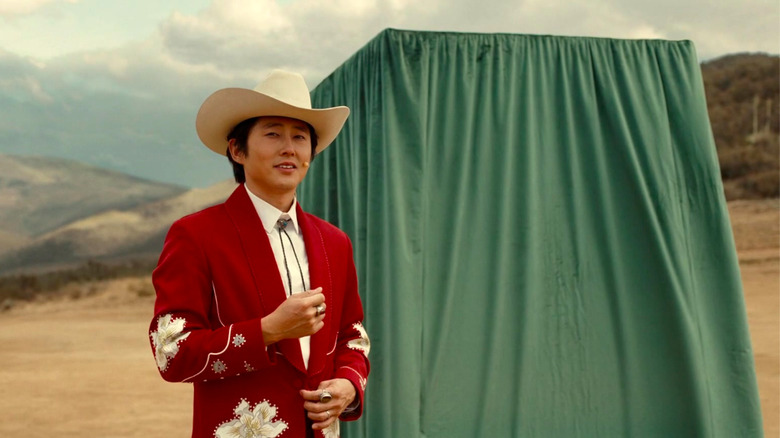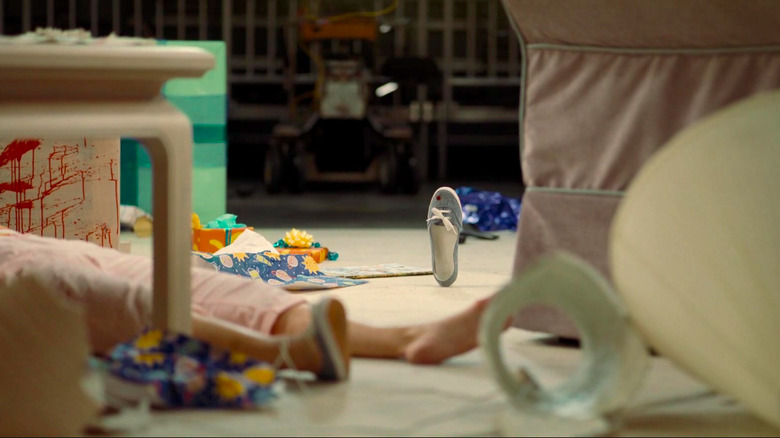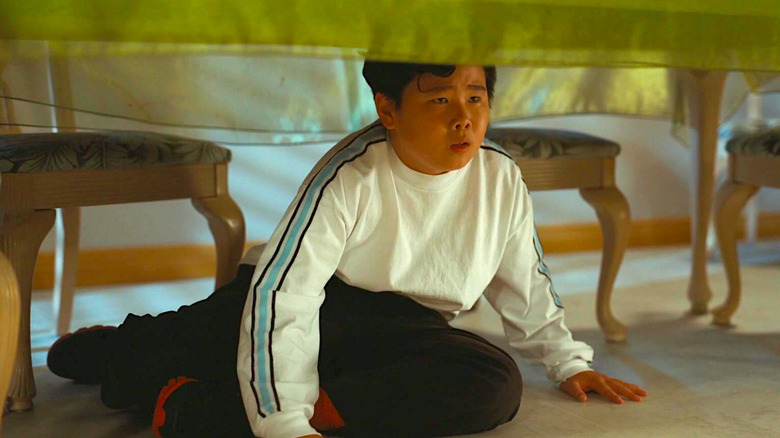Jordan Peele Explains What That Shoe Represents In Nope
Like many of Jordan Peele's films, his latest, "Nope" explores complex themes through the lens of horror, only this time tinged with a healthy bit of science fiction. "Nope" is a wild ride through the lives of OJ (Daniel Kaluuya) and Em (Keke Palmer) Haywood, Hollywood horse trainers living on their late father's ranch. When the siblings discover they are being stalked by a creature hiding in the clouds above their house, they quickly learn to adapt to the extraterrestrial animal's behavior in order to survive and ultimately defeat the predatory alien whom they affectionately dub "Jean Jacket."
Not everyone who comes into contact with Jean Jacket is as lucky (or as smart) about their communication with the animal, though. Jupe Park (Steven Yeun) — a childhood actor turned entertainer — tries to capitalize on Jean Jacket's impressive feeding habits which ultimately end up costing him his life. However, his ignorance in taking advantage of the wild animal relates back to his days starring in the popular 90s sitcom, "Gordy's Home," and the tragedy he witnessed on set after one of the show's star chimpanzees went on a killing rampage during filming.
Much of the "Gordy's Home" tragedy is relayed via flashback with the violence happening off-camera. However, there is one peculiar detail from the day that stands out to both a young Jupe and to viewers: the loose shoe of Jupe's on-screen sister Mary Jo balanced perfectly on its toe in the center of the stage. The shoe has puzzled fans of the film, often becoming a focal point for debate, and it turns out that this strange image is actually tied up with quite a bit of meaning.
The antithesis of a glass slipper
The image of the shoe is arresting. It's the first thing viewers see in the opening of the film. A powder blue Keds-style gym shoe with a spot of red blood on the toe, it seems to defy gravity, evoking a ghostly feeling of a pirouetting ballerina sans the actual ballerina or her foot. Like any good movie, the image isn't explained. Instead, we are left to puzzle it out for ourselves over the course of the film. We know it's important because a grown-up Jupe has framed it and placed it on display in his definitely creepy shrine-like collection of memorabilia from his days on the set of "Gordy's Home."
His impulse to preserve even a small part of the tragedy is reason enough to believe it holds some meaning, and if you really want to know just what that meaning is, Jordan Peele has finally offered up an explanation. In an interview for the podcast, "Happy Sad Confused," Peele says,
"The shoe represents a moment of where we check out of a trauma. And Jupe, he zones in on this little shoe, that's Mary Jo's shoe, that has landed in a precarious, odd situation. And this is the moment that he disassociates. So the shoe for me is in essence, in one way it's the impossible shot. That's an impossible moment."
This is a fitting explanation for a film so wrapped up in "impossible moments." For Jupe, the shoe offers him a way out of his present trauma, but, as Peele goes on to explain in the interview, it ultimately ends up being "a bad miracle."
Good shoes take you bad places
An article for Screen Rant delves deeper into the idea of the "bad miracle" theme in "Nope," explaining how much of the movie's action is a direct result of these specific moments. The shoe fits (a-ha!) into this category because it both rescues Jupe from the trauma of the moment, but also accidentally teaches him to continue to exploit creatures for profit. His decision to turn Jean Jacket into a spectacle at his theme park is a direct result of his experience with Gordy the chimpanzee. When Jupe notices the shoe, it is only moments before Gordy notices him. However, Gordy does not attack Jupe, instead offering him a fist so that the two can take part in the fist bump that presumably occurred often in the show between the boy and the animal.
Because Gordy does not harm him, Jupe equates his good fortune with the strange miracle of the perfectly balanced shoe. To him, it is the shoe that saved his life (even though it is more likely that the tablecloth preventing direct eye contact with Gordy is the actual reason the chimp doesn't attack him), and Gordy's predicament of being a mistreated entertainment animal goes entirely unrecognized. In a bizarre twist of fate, Jupe then grows up to become an over-confident entertainer, profiting off of all manner of icky situations, even his own trauma. In this way, the shoe becomes the type of "bad miracle" that "Nope" continually seeks to highlight in its quest to shed light on exploitation in the entertainment industry. It is the catalyst that gives way to a character's future bad behavior, which Jupe ultimately ends up paying the price for in the end.


